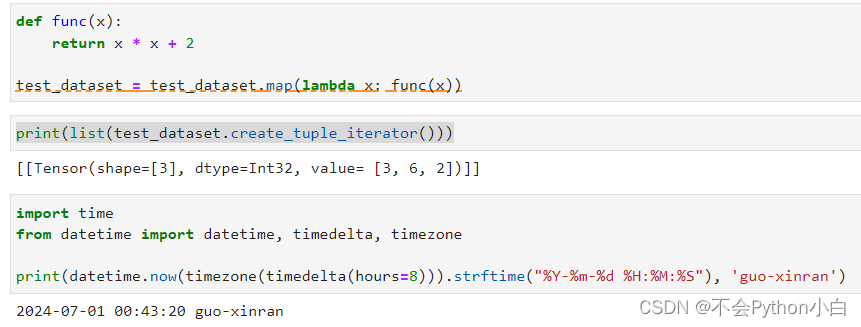基本介绍&快速入门&张量Tensor&数据集Dataset&数据变换Transforms&网络构建&函数式自动微分&模型训练&保存与加载
数据变换 Transforms
一般情况下,直接加载的原始数据并不能直接放到神经网络进行训练,此时我们需要对其进行数据预处理。MindSpore提供不同数据类型的数据变换(Transforms),配合数据处理Pipeline来实现数据预处理。所有的Transforms均可通过map方法传入,实现对指定数据列的处理。
mindspore.dataset提供了面向图像、文本、音频等不同数据类型的Transforms,同时也支持Lambda函数。
Common Transforms
此模块用于通用数据增强,其中一部分增强操作是用C++实现的,具有较好的高性能,另一部分是基于Python实现,使用了NumPy模块作为支持。
Compose
Compose将多个数据增强操作组合使用。接收一个数据增强操作序列,然后将其组合成单个数据增强操作。基于Mnist数据集呈现Transforms的应用效果。
from download import download
from mindspore.dataset import MnistDataset, transforms, vision
# 下载数据并加载
url = "https://mindspore-website.obs.cn-north-4.myhuaweicloud.com/" \
"notebook/datasets/MNIST_Data.zip"
path = download(url, "./", kind="zip", replace=True)
train_dataset = MnistDataset('MNIST_Data/train')
image, label = next(train_dataset.create_tuple_iterator())
print(image.shape)
# 缩放数据,并标准化
composed = transforms.Compose(
[
vision.Rescale(1.0 / 255.0, 0),
vision.Normalize(mean=(0.1307,), std=(0.3081,)),
vision.HWC2CHW()
]
)
train_dataset = train_dataset.map(composed, 'image')
image, label = next(train_dataset.create_tuple_iterator())
print(image.shape)
输出:
Downloading data from https://mindspore-website.obs.cn-north-4.myhuaweicloud.com/notebook/datasets/MNIST_Data.zip (10.3 MB)
file_sizes: 100%|███████████████████████████| 10.8M/10.8M [00:00<00:00, 135MB/s]
Extracting zip file...
Successfully downloaded / unzipped to ./
(28, 28, 1)
(1, 28, 28)
Vision Transforms
mindspore.dataset.vision模块提供一系列针对图像数据的Transforms。在Mnist数据处理过程中,使用了Rescale、Normalize和HWC2CHW变换。
Rescale
Rescale变换用于调整图像像素值的大小,包括两个参数:
- rescale:缩放因子。
- shift:平移因子。
图像的每个像素将根据这两个参数进行调整,输出的像素值为 o u t p u t i = i n p u t i ∗ r e s c a l e + s h i f t output_{i} = input_{i} * rescale + shift outputi=inputi∗rescale+shift。
这里我们先使用numpy随机生成一个像素值在[0, 255]的图像,将其像素值进行缩放。
import numpy as np
from PIL import Image
random_np = np.random.randint(0, 255, (48, 48), np.uint8)
random_image = Image.fromarray(random_np)
print(random_np)
输出:
[[198 166 131 ... 82 196 206]
[ 24 152 148 ... 117 27 56]
[ 90 63 238 ... 111 94 76]
...
[ 86 151 220 ... 83 3 236]
[ 26 201 63 ... 245 23 27]
[168 58 251 ... 59 162 161]]
为了更直观地呈现Transform前后的数据对比,使用Transforms的Eager模式进行演示。首先实例化Transform对象,然后调用对象进行数据处理。
rescale = vision.Rescale(1.0 / 255.0, 0)
rescaled_image = rescale(random_image)
print(rescaled_image)
输出:
[[0.77647066 0.6509804 0.5137255 ... 0.32156864 0.7686275 0.8078432 ]
[0.09411766 0.59607846 0.5803922 ... 0.45882356 0.10588236 0.21960786]
[0.3529412 0.24705884 0.9333334 ... 0.43529415 0.36862746 0.29803923]
...
[0.3372549 0.5921569 0.86274517 ... 0.3254902 0.01176471 0.92549026]
[0.10196079 0.78823537 0.24705884 ... 0.9607844 0.09019608 0.10588236]
[0.65882355 0.227451 0.9843138 ... 0.23137257 0.63529414 0.6313726 ]]
可以看到,使用Rescale后的每个像素值都进行了缩放。
Normalize
Normalize变换用于对输入图像的归一化,包括三个参数:
- mean:图像每个通道的均值。
- std:图像每个通道的标准差。
- is_hwc:bool值,输入图像的格式。True为(height, width, channel),False为(channel, height, width)。
图像的每个通道将根据mean和std进行调整,计算公式为
o
u
t
p
u
t
c
=
i
n
p
u
t
c
−
m
e
a
n
c
s
t
d
c
output_{c} = \frac{input_{c} - mean_{c}}{std_{c}}
outputc=stdcinputc−meanc,其中
c
c
c代表通道索引。
normalize = vision.Normalize(mean=(0.1307,), std=(0.3081,))
normalized_image = normalize(rescaled_image)
print(normalized_image)
输出:
[[ 2.0959775 1.688674 1.2431858 ... 0.61950225 2.070521 2.1978035 ]
[-0.11873532 1.5104787 1.4595658 ... 1.0649905 -0.08055063 0.28856817]
[ 0.7213281 0.37766582 2.6051068 ... 0.9886211 0.77224106 0.54313284]
...
[ 0.67041516 1.4977505 2.3759987 ... 0.63223046 -0.38602826 2.5796504 ]
[-0.09327886 2.1341622 0.37766582 ... 2.6942046 -0.13146357 -0.08055063]
[ 1.7141304 0.31402466 2.7705739 ... 0.32675287 1.637761 1.6250328 ]]
为什么要标准化或归一化?
- 加速模型收敛和训练过程
- 提高模型的稳定性,未归一化可能导致模型梯度爆炸或者梯度消失
- 减少模型过拟合,统一数据可以减少模型对输入数据随机变化的敏感度
HWC2CHW
HWC2CHW变换用于转换图像格式。在不同的硬件设备中可能会对(height, width, channel)或(channel, height, width)两种不同格式有针对性优化。MindSpore设置HWC为默认图像格式,在有CHW格式需求时,可使用该变换进行处理。
这里我们先将前文中normalized_image处理为HWC格式,然后进行转换。可以看到转换前后的shape发生了变化。
hwc_image = np.expand_dims(normalized_image, -1)
hwc2chw = vision.HWC2CHW()
chw_image = hwc2chw(hwc_image)
print(hwc_image.shape, chw_image.shape)
输出:
(48, 48, 1) (1, 48, 48)
更多Vision Transforms详见mindspore.dataset.vision。
Text Transforms
mindspore.dataset.text模块提供一系列针对文本数据的Transforms。与图像数据不同,文本数据需要有分词(Tokenize)、构建词表、Token转Index等操作。这里简单介绍其使用方法。
先定义三段文本,作为待处理的数据,并使用GeneratorDataset进行加载。
from mindspore.dataset import GeneratorDataset
texts = ['Welcome to Beijing']
test_dataset = GeneratorDataset(texts, 'text')
PythonTokenizer
分词(Tokenize)操作是文本数据的基础处理方法,MindSpore提供多种不同的Tokenizer。这里我们选择基础的PythonTokenizer举例,此Tokenizer允许用户自由实现分词策略。随后我们利用map操作将此分词器应用到输入的文本中,对其进行分词。
from mindspore.dataset import text
def my_tokenizer(content):
return content.split()
test_dataset = test_dataset.map(text.PythonTokenizer(my_tokenizer))
print(next(test_dataset.create_tuple_iterator()))
输出:
[Tensor(shape=[3], dtype=String, value= ['Welcome', 'to', 'Beijing'])]
Lookup
Lookup为词表映射变换,用来将Token转换为Index。在使用Lookup前,需要构造词表,一般可以加载已有的词表,或使用Vocab生成词表。这里我们选择使用Vocab.from_dataset方法从数据集中生成词表。
vocab = text.Vocab.from_dataset(test_dataset)
print(vocab.vocab())
输出:
{'to': 2, 'Welcome': 1, 'Beijing': 0}
生成词表后,可以使用map方法进行词表映射变换,将Token转为Index。
test_dataset = test_dataset.map(text.Lookup(vocab))
print(next(test_dataset.create_tuple_iterator()))
输出:
[Tensor(shape=[3], dtype=Int32, value= [1, 2, 0])]
Lambda Transforms
Lambda函数是一种不需要名字、由一个单独表达式组成的匿名函数,表达式会在调用时被求值。Lambda Transforms可以加载任意定义的Lambda函数,提供足够的灵活度。在这里,我们首先使用一个简单的Lambda函数,对输入数据乘2:
test_dataset = GeneratorDataset([1, 2, 3], 'data', shuffle=False)
test_dataset = test_dataset.map(lambda x: x * 2)
print(list(test_dataset.create_tuple_iterator()))
输出:
[[Tensor(shape=[], dtype=Int64, value= 2)], [Tensor(shape=[], dtype=Int64, value= 4)], [Tensor(shape=[], dtype=Int64, value= 6)]]
可以看到map传入Lambda函数后,迭代获得数据进行了乘2操作。
我们也可以定义较复杂的函数,配合Lambda函数实现复杂数据处理:
def func(x):
return x * x + 2
test_dataset = test_dataset.map(lambda x: func(x))
print(list(test_dataset.create_tuple_iterator()))
输出:
[[Tensor(shape=[3], dtype=Int32, value= [3, 6, 2])]]
后续会更新更详细的Transforms操作~~~
